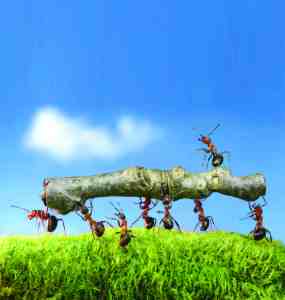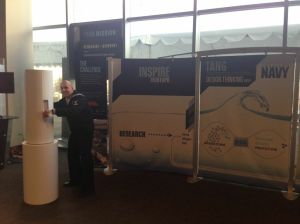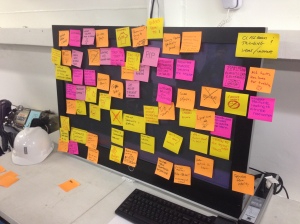By: LT Dave Nobles

On Friday, the sixth installment of San Diego’s Waterfront Athena took to the Coronado Brewing Company tasting room with some amazing ideas that will one day shape the Fleet.
This time, we had ten presenters from four different organizations in the San Diego area, all pitching great concepts geared toward making the Navy better, one innovation at a time. For more about how The Athena Project works, check this out.
There were plenty of familiar faces at the event – a huge contingent of engineers from SPAWAR’s System Center – Pacific were on the scene to take part in the ideation, and Dr. Ben Migliori talked to the crowd, more than 60 strong, about the upcoming Grassroots S&T/Athena collaboration workshop. More to follow on that very soon!
Then, we had some new friends joining in this time around. From IBM, Jim Pietrocini gave a quick pitch on Social Collaboration within the Navy, and the future of knowledge sharing. And, we were lucky to have our new friends from the innovative San Diego tech company, Interknowlogy, showcase some of their cool new technology. Representing the organization, Rodney Guzman helped us out by picking the first presenter, and then it was time to get down to the ideas.
Here’s how it all went down:
***Waterfront Athena Six’s Admiral Sims Award for Intellectual Courage***
“The Effing Awesome 7000” – ENS Jason Benning & DCC(SW) Jake Wright, USS BENFOLD
While the name is a bit squirrely, the concept is not. In fact, it’s one of those ideas that you hear and you say, “Why didn’t I think of that?”
On every ship at sea, each Sailor is a firefighter. In the unfortunate event that a fire were to break out aboard while underway, Sailors not only have to fight it, but they also have to figure out how to get rid of the firefighting water and residual smoke afterward.

From the “why haven’t we been doing this for decades” department, DCC(SW) Jake Wright and ENS Jason Benning present the “Effing Awesome 7000”
With a simple prototype, these two Damage Control innovators demonstrated a ridiculous efficiency increase in desmoking efforts. Typically, Sailors hook up a RAM fan to what’s called an elephant trunk, or a huge hose to transport smoke from an interior space to the atmosphere topside. A RAM fan is rated at 2,000 Cubic Feet per Minute (CFM) and is typically used to desmoke because it hooks up to the elephant trunks. However, a shipboard Box Fan, rated at a much higher capacity (3,200 CFM), has no way to hook up to an elephant trunk.
Until now.
With a prototype made out of a sheet of metal and a trash can, these two Sailors invented an adaptor that leverages the increased output capacity of the Box Fan with the elephant trunk, resulting in the ability to desmoke a shipboard space in nearly half the time. The effort was good enough to bring home the day’s biggest prize, and Benning & Wright guaranteed that videos of the “Effing Awesome 7000” would be postable soon!
Runner Up: The SPY Ladder – LTJG Adam Levine, USS BENFOLD
Once the crowd realized that BENFOLD’s Systems Test Officer wasn’t THAT Adam Levine, they were able to focus on his great idea.

Yes, folks, those are little zombie people cleaning that foamcore SPY array.
With a few brackets and a removable ladder, LTJG Levine proposed an innovative solution for cleaning and repairing SPY arrays on Cruisers and Destroyers, thereby saving the Navy millions of dollars over the life of a ship. Each time a ship requires array cleaning or repair, the only present solution is to erect scaffolding for the duration of the maintenance period, which costs nearly $20K each time. With LTJG Levine’s innovative ladder, which would be affixed to rails at the top and bottom of each fragile array, Sailors could clean the arrays without scaffolding and effect repairs on the fly when the situation demanded it. Not only would the money savings be staggering, Sailors would finally have a solution to repair arrays at sea which would greatly enhance readiness in important mission areas like Ballistic Missile Defense.
Third Place: Jamming Drones – FC3 Josh Wade & FCSN Dallas Baranosky, USS BENFOLD
Sometimes innovations come to you when you’re engaged in focused thought, directing all your available brainwaves toward the creative effort. Then, there are times when you’re exhausted on a midwatch conversing with your buddies and you stumble across a great idea. In the case of these two Fire Controlmen, the latter is true.

The Midwatch: Hub of creative thought since 1775.
Late one night, after a discussion of threat missiles and their associated seeker types, these Sailors suggested an innovative solution to a potential home-on-jam threat. In their proposal, a ship could launch an unmanned aerial vehicle equipped with an organic jamming pod from its Vertical Launch System (VLS). Under shipboard control, the drone could then fly out a few miles from the ship and stay airborne for multiple hours, jamming any and all inbound missiles that might have a home-on-jam capability, causing the enemy missiles to fly at the drone instead of the warship. The pair is currently working with the team from SPAWAR to develop their concept.
Spray-on PCMS – CTTSN Lucas Amido, USS BENFOLD
In the day’s first presentation, CTTSN Amido proposed a method to save time and maintenance costs by replacing ships’ stick-on radar cross-section reducing countermeasure systems by creating an aerosol version of the coating. In his two-part system, Sailors could spray on a coating that would serve the same purpose as the Navy’s Passive Countermeasure System (PCMS), then seal it with a second solution.
Shipboard Robotics Club- FC2 Mike Owen & IC3 Katie Rogers, USS BENFOLD
Many of today’s enlisted ratings require technical skill sets to deal with extraordinarily complex systems, and the Navy is currently trending toward more advanced systems that will demand even greater technical acumen. As a fun way to sharpen these skills, FC2 Owen and IC3 Rogers proposed the creation of a Robotics Club onboard ships. Sailors, both enlisted and officer, could work together to build robots and see their creations square off against other commands and community clubs while developing a skill set that will serve tomorrow’s Fleet well.
Pigeons for Bandwidth – Dr. Sunny Fugate, SPAWAR SCC PAC
In what was certainly the most entertaining pitch of the day, Dr. Fugate delivered the ultimate innovative communications solution to solve data latency issues at sea and resolve challenges that Sailors face in low bandwidth: Pigeons. Backed by compelling data, Dr. Fugate proposed using trained pigeons to transfer data packages between units. Ok, ok: There are some challenges, sure – like training the pigeons, attaching the data to pigeons, not losing the pigeons, etc. that could result in increased data latency (or loss of critical information). However, Dr. Fugate’s pitch brought some welcome technology-driven levity to Athena.

“Just one word: Pigeons.”
eyePARTS – LSSN Vashti Kronaizl, USS BENFOLD
Often times, the Navy’s supply system can be a source of frustration for not only Logistics Specialists, but any Sailor trying to find that specific part of a system or subsystem. As a solution to this problem, LSSN Kronaizl proposed building a visual database of all parts associated with systems to enable a camera-based program to search for systems based on a photo of a specific part. While there are several challenges to this system, like differentiating gasket sizes and identifying small parts that are used in multiple systems, LSSN Kronaizl’s vision for the future of the Supply would make Sailors’ lives a whole lot easier!
Super Commos- LTJG James Martin, USS BENFOLD
BENFOLD’s Fire Control Officer explained the importance of the shipboard communications suite to a variety of missions that ship’s conduct, from Ballistic Missile Defense to Air Warfare to Visit, Board, Search & Seizure. As such, he proposed that Communications Officers onboard ships should be second-tour division officers because of the relative importance of communications, both voice and data, to the mission. LTJG Martin proposed that, if altering the division officer sequencing plan was a bridge too far, Communications Officers should at least be afforded the opportunity to attend Communications Officer School prior to reporting to their commands. Currently, there is no such requirement.
Virtual Flight Academy – Flack McGuire
In a pitch right from the pages of Orson Scott Card’s Ender’s Game, Flack McGuire talked about a way to determine the best pilot candidates BEFORE they arrived at Flight School. He likened the way that we find pilots in the military to hiring an inexperienced quarterback to helm an NFL team. With exercises and tests given to prospective pilots at younger ages, Flack’s Virtual Flight Academy aims to identify the best qualities for future pilots before selection, ensuring that the Aviation Community is stocked with the most talented personnel possible.
3M Billets – HM3 Michael Gardner, USS GREEN BAY
The Navy’s Maintenance and Material Management (3M) program often elicits a visceral response from those that have to use it every day, and HM3 Gardner is no exception. Since the 3M program is extremely admin-intensive, HM3 Gardner proposed forming a separate division onboard ships specifically to manage the various maintenance actions taking place all over the ship. These Sailors’ primary duties would be to schedule preventative maintenance, ensure that maintenance requirement cards were always up-to-date, generate reports and implement administrative changes to the maintenance index pages. While the program was not specifically designed to have a separate division maintain it, the increasing administrative burden that comes with 3M makes HM3 Gardner’s solution quite realistic.
At the event, we recorded each pitch, and once the video has been edited, we’ll post those to the Athena Facebook page and right here on this blog.
With so many great ideas, it was awesome to see the real-time innovation and collaboration between Sailors and Scientists that happens at an event like this. It’s both inspiring and encouraging for Military Innovation that The Athena Project continues to grow. While the West Coast iteration of The Athena Project continues to march along, regions are throwing together Athena Projects all over the place! Just last month, the first-ever Athena East took Old Dominion University by storm, and next month The Athena Project will be visiting the great state of Washington as Athena Northwest gets in on the action.
As always, we’re truly humbled by the support that this initiative has received both from the fleet and from industry. It’s amazing to think that what started as an unfortunately-named experiment called WikiWardroom has blossomed into a stage for Sailors to have their voices heard!
Thank you to everyone who participated in this event and we can’t wait to see you guys at our next one! And of course, a very special thank you goes out to our friends at Coronado Brewing Company for helping us host this awesome event.
Connect with The Athena Project on Facebook: www.facebook.com/athenanavy or follow us on Twitter: @AthenaNavy. Interested in starting a movement of your own? Message us, or e-mail athenanavy@gmail.com!















